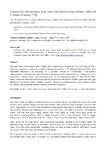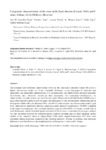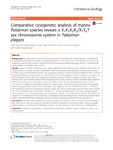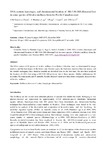Buscar
Mostrando ítems 1-5 de 5
Genome sizes and karyotypes in the razor clams "Ensis arcuatus" (Jeffreys, 1865) and "E. siliqua" (Linnaeus, 1758)
(CNRS - Station Biologique de Roscoff- ABiMS, 2008-03)
[Abstract] The razor clams Ensis arcuatus and E. siliqua show a diploid DNA content of 3.85 ± 0.049 pg and 4.00 ± 0.050 pg, respectively. Both have a diploid chromosome number of 38 although their karyotypes show remarkable ...
Cytogenetic characterisation of the razor shells "Ensis directus" (Conrad, 1843) and "E. minor" (Chenu, 1843) (Mollusca: Bivalvia)
(Springer Nature, 2012-04-26)
[Abstract] The European razor shell Ensis minor (Chenu 1843) and the American E. directus (Conrad 1843) have a diploid chromosome number of 38 and remarkable differences in their karyotypes: E. minor has four metacentric, ...
Comparative cytogenetic analysis of marine “Palaemon” species reveals a X₁X₁X₂X₂/X₁X₂Y sex chromosome system in “Palaemon elegans”
(Springer, 2017-10-12)
[Abstract]: The maintenance of species and the promotion of speciation are closely related to chromosomal rearrangements throughout evolution. Decapoda represents the most species-rich order among crustaceans and, despite ...
DNA content, karyotypes, and chromosomal location of 18S-5.8S-28S ribosomal loci in some species of bivalve molluscs from the Pacific Canadian coast
(Canadian Science Publishing, 2000-12)
[Abstract]: The DNA content of 10 species of bivalve molluscs from British Columbia coast was determined by image analysis, and the karyotypes of the horse clam “Tressus capax”, the bent-nose macoma “Macoma nasuta”, and ...
Karyotypes and Ag-NORs of the mussels Mytilus californianus and M. trossulus from the Pacific Canadian coast
(Elsevier, 1997-01-01)
[Abstract] The karyotypes and the nucleolus organizer regions (NORs) of “M. californianus” and “M. trossulus” from the Pacific coast are reported here for the first time. The karyotypes show seven metacentric and seven ...










